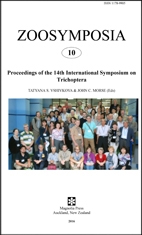Abstract
In a study on flight activity it was observed that Trichoptera were attracted to a superactinic or UV light at a site along the lower Groot River near Nature’s Valley in the Western Cape, South Africa. The frequency of insects passing selected fixed points in space was recorded photographically, after dusk, on 44 days between October 2011 and May 2012. All digital images of insects were identified to species, where possible, and abundance of species over selected time periods was determined. Water and air temperature, relative humidity, barometric pressure, wind direction and speed were continuously recorded during each recording event. Total dissolved solids (TDS), electrical conductivity, pH, the percentage of cloud cover, rain at the time of the survey, and rainfall prior to the survey, were all recorded. The dominant species during all surveys, Athripsodes bergensis Scott, revealed a modal peak of flight activity around 50 minutes after sunset which was strongly influenced by climatic variation. The presence of egg masses carried by females was observed from the middle of November through March, with the highest percentage of females with egg masses found from late November to early December. Other species of Trichoptera that were recorded flying appeared later after sunset than did A. bergensis. Statistically the most important factor influencing flight activity was the time in minutes after sunset. Clear, cloudless conditions resulted in reduced flight activity. Information on flight activity can be used to determine the optimum weather conditions and times for collecting Trichoptera when using light sources.
References
Bellingan, T.A. (2011) The diversity of aquatic insects in the Tsitsikamma region, with implications for aquatic ecosystem conservation. MSc Thesis, Rhodes University, Grahamstown, xvi + 187 pp.
Corbet, P.S. (1965) Asymmetry in eocrepuscular diel periodicities of insects. The Canadian Entomologist, 97, 878–880.
http://dx.doi.org/10.4039/ent97878-8Corbet, P.S. & Tjonneland, A. (1955) Rhythmic flight activity of certain East African Trichoptera. Nature, 157, 1122–1123.
http://dx.doi.org/10.1038/1751122b0Corbet, P.S. & Tjonneland, A. (1956) The flight activity of twelve species of East African Trichoptera. University of Bergen Arbok Naturvitenskapelig rekke, 9, 1–49.
Crichton, M.I. (1960) A study of captures of Trichoptera in a light trap near Reading, Berkshire. Transactions of the Royal Entomological Society of London, 112, 319–344.
de Moor, F.C. & Bellingan, T.A. (2010) A survey of macroinvertebrate diversity of eleven rivers in and around the Tsitsikamma National Park, Eastern Cape, South Africa. Final Report for the Tsitsikamma Steering Committee, xii + 133 pp + Appendices 173 pp.
Harris, T.L. (1971) Crepuscular flight periodicity of Trichoptera. Journal of the Kansas Entomological Society, 44, 295301.
Ivanov, V.D. (1991) Evolution of flight of caddis flies. Proceedings of the 6th International Symposium on Trichoptera. In: Tomaszewski, C. (Ed.), Adam Mickiewicz University Press, Poznań, pp. 351–357.
McIlleron, W.G. and de Moor F.C. (2011) Photography of Trichoptera (Insecta) in flight. In: Majecka M., Majecka J. & Morse J. (Eds), Proceedings of the 13th International Symposium on Trichoptera. Zoosymposia, 5, 297–318. Available from: http://www.mapress.com/zoosymposia/ (accessed 20 June 2014)
Nimmo, A. P. (1966) The arrival pattern of Trichoptera at artificial light near Montreal, Quebec. Quaestiones entomologicae, 2, 217–242.
Petersson, E. (1989) Swarming activity patterns and seasonal decline in adult size in some caddis flies (Trichoptera: Leptoceridae). Aquatic Insects, 11, 17–28.
http://dx.doi.org/10.1080/01650428909361343Scott, K.M.F. (1958) Some new caddis flies (Trichoptera) from the Western Cape Province - 2. Annals of the South African Museum, 44, 39–52.
Solem, J.O. (1978) Swarming and habitat segregation in the family Leptoceridae (Trichoptera). Norwegian Journal of Entomology, 25, 145–148.
Solem, J.O. (1984). Adult behaviour of North European caddisflies. In: Morse, J.C. (Ed.), Proceedings of the 4th International Symposium on Trichoptera. Series Entomologica 30, Dr W. Junk Publishers, The Hague, pp. 375–382.
STATISTICA, (2010) Statsoft release 9. Registered to Rhodes University, Grahamstown.
Wagner, R., Marxsen, J., Zwick, P. & Cox, E.J. (2011) Central European Stream ecosystems: The long term study of the Breitenbach. Wiley Blackwell, Singapore, 672 pp.
http://dx.doi.org/10.1002/9783527634651Waringer, J.A. (1991) Phenology and the influence of meteorological parameters on the catching success of light-trapping for Trichoptera. Freshwater Biology, 25, 307–319.
http://dx.doi.org/10.1111/j.1365-2427.1991.tb00493.x

